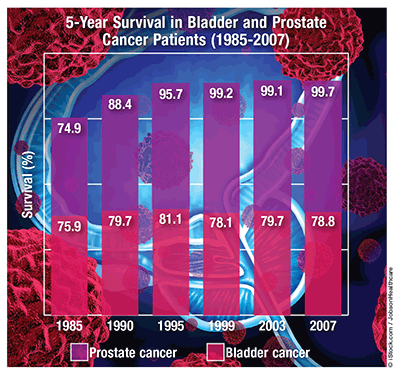US Pharm. 2015;40(8):18.
Prostate cancer (PC) and bladder cancer (BC) are among the top 10 sites of new cancer cases and deaths in men. According to United States Cancer Statistics, the incidence rates for both BC and PC decreased from 2002 to 2011.
PC Prevalence and Survival: PC, the second most common type of cancer in men, represents 13.3% of all new cancer cases diagnosed. After age 50 years, the risk of developing PC increases dramatically, and PC is diagnosed most frequently in patients aged 65 to 74 years. The median age at diagnosis is 66 years. PC is most prevalent (215.7/100,000) among African Americans, with a mortality rate two times higher (46.3/100,000) than that for other ethnic groups. It is the second most common cause of death from cancer among white, African American, American Indian/Alaska Native, and Hispanic men, and the fourth most common among Asian/Pacific Islander men. From 2008 to 2012, the annual number of new PC cases was 137.9 per 100,000. According to the National Ambulatory Medical Care Survey, there are >2 million PC survivors, and one in five men (220,800) will be diagnosed with PC in 2015. Five-year survival is nearly 100% when the cancer is confined to the prostate, and 29% when it spreads.
BC Prevalence and Survival: BC is the fourth most common cancer in men and the 11th most common in women. Men are four times more likely than women to develop BC (35.8/100,000 vs. 8.7/100,000). Across all age groups, per 100,000 BC cases, more men than women died (7.7 vs. 2.2), but among patients aged >75 years, more women died. The risk of developing BC in one’s lifetime is 1 in 26 in men and 1 in 90 in women. White individuals are diagnosed with BC almost twice as often as African American or Hispanic persons. American Indians/Alaska Natives have the lowest BC rate. BC has an average age at diagnosis of 73 years. In 2009, 74% of 71,000 persons diagnosed were men, 90% were aged >55 years, and 70% were >65 years. Ninety percent of BC cases are urothelial carcinoma, of which 70% are superficial urothelial carcinoma. In about one-half of cases, patients have in situ BC; in 35% of cases, the cancer has invaded deeper layers but is contained in the bladder. In the remaining cases, the cancer has spread to tissues outside the bladder, and in 4% of cases it has spread to distant sites. About 577,400 people had BC in 2012, and 77.4% of patients survived ≥5 years.
To comment on this article, contact rdavidson@uspharmacist.com.





